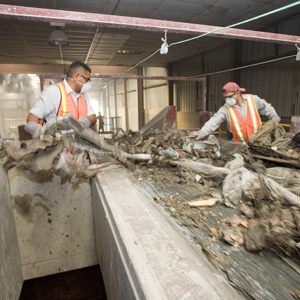Debris Management
 Debris Management according to the Army Corps of Engineers refers to the collective operations of demolition, clearance, removal, transport, temporary storage, segregation, reduction, and ultimately, disposal of debris whether generated by natural disaster or terrorist event. GreenCo has the expertise and experience to properly manage disaster debris so as to protect human health, comply with regulations, and minimize or prevent environmental impacts. With professionals from GreenCo leading the debris management operations for your community, your staff can attend to the other competing priorities that must be managed during such events.
Debris Management according to the Army Corps of Engineers refers to the collective operations of demolition, clearance, removal, transport, temporary storage, segregation, reduction, and ultimately, disposal of debris whether generated by natural disaster or terrorist event. GreenCo has the expertise and experience to properly manage disaster debris so as to protect human health, comply with regulations, and minimize or prevent environmental impacts. With professionals from GreenCo leading the debris management operations for your community, your staff can attend to the other competing priorities that must be managed during such events.
Debris Management falls into several time phases, each of which are related to the four operational stages of the Disaster Management Cycle: 1) Before a disaster strikes [Normal Operations]—a good time for planning and shoring up resources for adequate debris management. 2) Impending disaster [Increased Readiness Stage] — With some disasters such as hurricanes, we have some warning beforehand. It is during this time that GreenCo moves resources in position and follows other guidelines previously decided upon in the community disaster plan. 3) Within 24 hours after the event and up to 10 days [Response Stage], emergency crews remove debris from main roadways to clear the way for emergency vehicles. 4) Following the end of first 10 days and moving forward [Recovery Stage], Debris Management is fully operational and the main roadways are cleared. Debris management will continue from this point forward until the community has been recovered. The time will vary according to the magnitude of the disaster—from a few months to over a year.
GreenCo assists communities in all aspects of debris management by following approved industry processes along with state and federal guidelines to ensure FEMA compliance.
OVERVIEW OF GREENCO SERVICES ASSOCIATED WITH DEBRIS MANAGEMENT
- Debris Management Site Construction
- Removal of Vegetative Debris
- Removal of C& D Debris
- Debris Sorting/Classification
- Debris Reduction
- Grinding
- Incineration
- Recycling/Reusing Debris
Debris Management Site Construction
Over the years, employees at GreenCo have successfully constructed, managed and remediated Debris Management Sites back to conditions often better than their original state. The Debris Management Site is the location where we initially take the debris to be processed (segregated or reduced and then transported to an appropriate destination such as a recycle facility or a designated landfill).
GreenCo prepares and maintains a Debris Management Site on a location as approved by community officials to accept and process all eligible disaster debris. Preparation and maintenance of the site usually includes the maintenance of the Debris Management Site approach and interior road(s) for the entire period of debris hauling including provision of crushed concrete for any roads that require stabilization for ingress and egress. Each site includes a roofed inspection tower sufficient for inspectors whose job it is to ensure all incoming and existing loads meet all specifications as previously defined by the community officials in their RFP for the project.
GreenCo will tour the locations of your current debris management site(s) and evaluate their adequacy for you. It has been our experience that often the number of these sites is not adequate. The time to repair the roof is when the sun is shining, and so it is with putting plans in place for the location of a Debris Management Site.
Removal of Vegetative Debris
When major natural disaster events happen such as hurricanes, tornados, floods and ice storms, the landscape is strewn with downed trees and large shrubs that have been uprooted. FEMA often uses the terms “vegetative” for natural debris and “construction and demolition” (C&D) for man-made debris.
FEMA’s Public Assistance Program generally provides funding for removal of vegetative debris from public right-of-way. However, there are many questions to be considered to ensure that vegetative debris removal is done following FEMA processes, requirements and guidelines. Debris removal tasks that are not undertaken following these processes could result in failure to qualify for reimbursement under FEMA’s debris regulations.
GreenCo employees are trained in the effective and efficient removal of vegetative debris according to FEMA requirements—from monitoring and documenting our removal tasks, to properly treating stumps, to determining how many debris removal runs/passes will be necessary for the removal of vegetative debris. You can depend on us to ensure the job is done right and in accordance with all local, state, and federal regulations.
Removal of Construction and Demolition (C&D) Debris
Man-made structures—both commercial and residential—are often damaged as the result of a disaster event. According to FEMA, C&D debris includes “damaged components of buildings and structures, such as lumber and wood, gypsum wallboard, glass, metal, roofing material, tile, carpeting and floor coverings, window coverings, pipe, concrete, fully cured asphalt, equipment, furnishings, and fixtures.”
Adjusters International identifies three categories of debris removal according to where it is found: 1) Public property debris removal 2) Private property debris removal and 3) Private property demolitions. The legal complexities of responsibility increase according category. For example, if the debris is located on public property such as beaches, parks, golf courses, the responsibility for removal is straightforward and rests with local government. Debris removal from private property can also be eligible for FEMA reimbursement; however, more documentation is involved and the FEMA federal coordinating officer must give approval prior to the debris removal.
Private property demolitions are the most complicated (legally and operational) of all three location categories due in great part to the amount of documentation required by FEMA and often the involvement of many stakeholders. Even so, when a structure presents an immediate threat to the health and safety of the community, the FEMA Public Assistance group supervisor can authorize it.
The three basic requirements for demolishing buildings on private property:
1) The structure must have been damaged as a direct result of the disaster;
2) The applicant must show the structure is an immediate threat to the public;
3) The applicant must have legal authority to act under law, code or ordinance.
The experienced professionals of GreenCo understand the details of all the various processes and considerations associated with C&D removal—both legal and operational requirements.
Debris Sorting and Classification
Debris sorting and classification involve critical tasks in the overall debris management process. Much of the debris from a disaster event contains regulated material that requires special handling to comply with local, state and federal regulations. Improper handling and disposal of regulated material can lead to penalties and denial of FEMA funding.
Common types of debris that require special handling include the following:
- Solvents, paint cans and other hazardous materials such as yard fertilizers and pesticides
- C&D debris containing asbestos
- “e-waste”—electronic equipment such as computers, televisions, etc.
- Major appliances such as stoves and refrigerators (often referred to as “white goods”
GreenCo professionals are trained in the handling and proper disposal of regulated material. When trucks enter the debris management site they are usually hauling either vegetative debris or C&D debris. After completing necessary paperwork, the drivers are directed to the appropriate area of the debris management site where they will unload their cargo according to debris type they are hauling.
The central task of sorting and handling C&D debris is to separate the hazardous from the non-hazardous materials. Thus most sites end up with areas designated for white goods; electronics; asbestos materials; paint, poison and petroleum products; recyclable building materials such as stone and bricks; recyclable plastics and glass; reusable areas as some of the materials picked up are still in usable condition to be reused for their original purpose—for example, a lawn chair in near perfect condition.
GreenCo professionals are experienced in sorting and classifying debris as recycling is an important aspect of our company operations.
Debris Reduction Grinding Incineration
Primarily it is vegetative debris that is subjected to reduction at the debris management site. Vegetative debris often represents a significant proportion of disaster debris. When clean, it can be chipped or ground up for re-use. Chipping and grinding is estimated to reduce up to 75% of the volume of vegetative debris.
Because of the potentially huge volume of vegetative debris following a disaster, burning (estimated to reduce waste by 90%) may be a preferred method. However, burning or chipping for reuse are not safe options for reducing vegetative debris contaminated with sewage, oil, or other contaminants.
GreenCo professionals are experienced in assisting communities in making the best decisions for reducing their vegetative debris. Our decisions take into consideration all the many important variables such as environmental concerns, landfill space conservation, and FEMA reimbursement.
Recycling/Reusing Debris
Recycling and reusing are separate but related concepts. Both are forms of reusing, but recycling involves the breakdown of items into their raw materials, which are then used to create new items. Reusing is finding a new way to use items so we don’t have to throw them out. Reusing does not involve all the energy, expense and often pollution that are involved in reducing items to their raw materials.
Reuse can mean purchasing non-disposable items or it can mean passing an item along to another person for continued use. So, rather than using paper towels to clean the house, you use a washable rag; and, instead of throwing out the clothes or toys your children have outgrown, you pass them along to a neighbor, charity or church.
GreenCo professionals are trained to separate items at the debris management site into items that might be sold as second-hand items for reuse and items such as aluminum cans* that are better suited as items to be recycled for their raw materials. We are passionate about greening up the footprint of our Gulf Coast communities as much as possible. Not only is it good for our beautiful environment, it’s also great for our wallets.
According to the Aluminum Association: Americans throw away nearly $1 billion worth of aluminum cans every year. The aluminum industry pays out more than 800 million dollars a year for recycled cans. The U.S. industry can recycling rate is approximately 67 percent, thus nearly a billion dollars of recycling profit can be gained.
GreenCo Services LLC
Disaster Recovery & Debris Management
Phone: 251-971-2210
Fax: 251-971-2139
Email: [email protected]
Office Location:
GreenCo Services, LLC
PO Box 111 Foley, AL 36536


